Aviation of the Red Army of the Great Patriotic War (part of 3) - Pe-2 and Tu-2 dive bombers
It should be noted that the Pe-2 became the most massive front-line diving bomber ever made in the USSR. In total, from 1940 to 1945, 11 of these machines were produced. During the war years, Pe-427 aircraft took part in battles on all fronts, they were used not only in land, but also in the sea aviation. This aircraft was used as a bomber, reconnaissance, and even a fighter. It is difficult to say how the future fate of this promising bomber would have developed if its creator V.M. Petlyakov had not died in a plane crash on January 12, 1942.
Pe-2 dive bomber
State tests "weave" were completed 10 May 1940 of the year, and already 23 June aircraft took to mass production. On the serial model, the cockpit was shifted slightly forward. Behind the pilot's seat, slightly to the right, was the navigator's seat. The nose of the cabin was glazed, which allowed for aiming at the time of the bombing. The navigator could also fire from the ShKAS machine gun, which was mounted on the pivot mount, which had fired back. Behind the rear edge of the wing of the aircraft was the position of the gunner-radio operator who controlled the ventral “dagger” installation of the SHKAS.
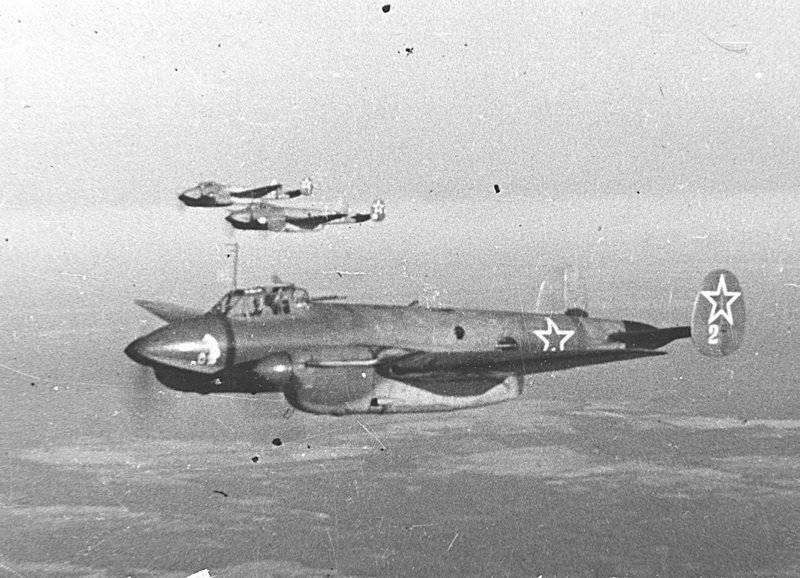
The Pe-2 production aircraft were equipped with M-105P engines, which had an 1100 hp takeoff power. with drive centrifugal superchargers, as well as variable pitch screws VISH-61P. Aircraft engines had water cooling, radiators were located in the wing of the aircraft to the left and right of each engine. Oil radiators were located directly under the engines. All aircraft fuel tanks were protected and had an inert gas injection system - cooled exhaust gases from the engines, which made it possible to reduce the possibility of a fire in the event of damage to the fuel tank during an air battle.
On the Pe-2 for the first time in the USSR, a system of electrical control of many mechanisms was applied. The design of the aircraft was used around 50 electric motors 5 of various types with power from 30 to 1 700 W. They were engaged in servicing various units of the bomber: they changed the pitch of the screws, opened and closed the radiator flaps, put in action valves, pumps, shields. Also, these motors were produced by the command of the AP-1 dive-machine or released the aerodynamic brakes, which were located under the wing consoles and were used during the dive.
At the bomber, various options for bomb load in the form of fragmentation, high-explosive and special bombs (for example, chemical, concrete-breaking, lighting) with a total mass up to 1000 kg were provided. In this case, the largest bomb that a dive bomber could take was FAB-500. The bomb load was distributed as follows: 600 kg. could fit inside a large bomb bay (400 kg), which was located in the central part of the fuselage, as well as two bomb compartments in the tail section of the nacelle (100 kg). Another 400 kg bombs could be placed on the external sling. Small bombs were placed in special cassettes. At the same time in the dive process it was possible to drop only bombs from the external suspension. No devices for removing bombs from the bomb compartment on the aircraft were provided.
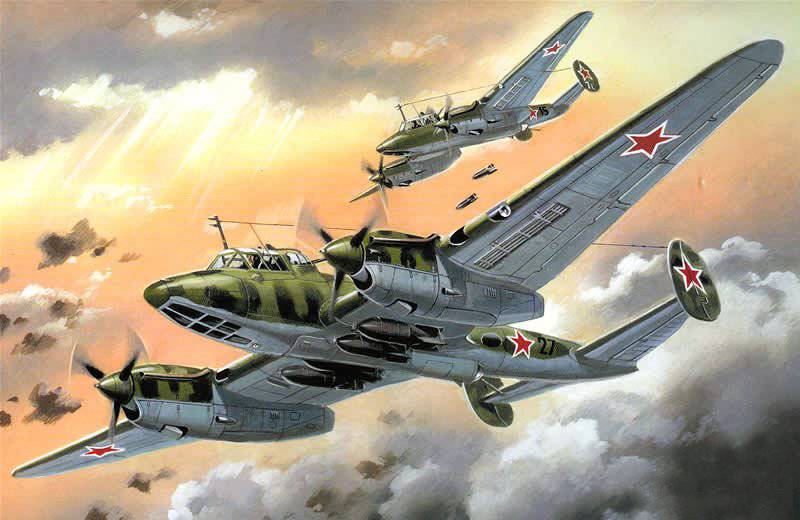
Unfortunately, before the start of World War II, Pe-2 did not have time to fully pass either operational or military tests, the order for which was given by the command of the Red Army Air Force only in April 1941. The situation was even worse with the retraining of pilots to a new car. While in the Air Force as a whole this indicator for the new technology was 10%, then in bomber aviation it was only 5%. At the same time, the pilot training programs were simplified to the limit. The crews of dive bombers were not trained in dive bombing, and were not prepared for high-altitude flights. Only individual commanders could use "pawns" at heights up to 7 thousands of meters.
Largely due to the confluence of these factors, the activity of the Pe-2 in the early days of the war was small. Despite this, the "pawns" were able to prove themselves on the very first day of the war. 17 bombers from the 5 th bomber regiment successfully bombed the Galati Bridge across the r. Rod. Over time, their combat work at the front only increased. The value of Pe-2 dive bombers was their speed, maneuverability, as well as survivability. Thanks to these qualities, the aircraft could operate in the daytime in conditions of superiority of German aircraft in the air. In this case, the "pawns", especially if they were freed from the bomb load, could take the fight or avoid interception. Especially effective aircraft after the 13-series, received a large-caliber 12,7-mm offensive and defensive machine guns.
German Feldwebel A. Mudin from the 51 Fighter Squadron (JG51) shot down near Bobruisk during interrogation stated that he considers the Pe-2 to be the best Soviet aircraft. According to him, this car was distinguished by good fire protection and high speed, it was dangerous for enemy fighters. There is nothing surprising in his words, since he was shot down by the shooter Pe-2, and in terms of its speed, the plane was not inferior to the Bf 109E fighter. Also in the first months of the war, the Germans quite often confused the Pe-2 with their own Do 17Z and Bf 110 aircraft, which also had two-tail plumage, and did not attack these machines.
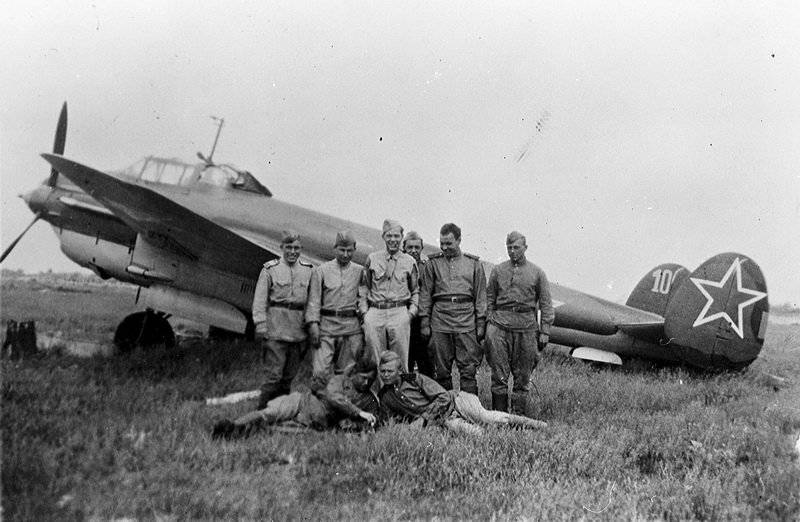
Performance characteristics of the Pe-2:
Dimensions: wingspan - 17,6 m., Length - 12,6 m., Height - 3,92 m.
Wing area - 40,5 square. m
Aircraft takeoff weight - 7 550 kg.
Engine type - 2 M-105, power of each 1100 hp
The maximum speed is 540 km / h.
Practical range: 1 200 km.
Practical ceiling: 8 700 m.
Crew - 3 person.
Armament: 2X12,7-mm UB machine gun, up to 4-x 7,62-mm ShKAS machine guns
Bomb load normal - 500 kg, maximum - 1 000 kg.
Dive bomber Tu-2
The Tu-2 bomber project was developed as early as 1939, and the first aircraft under the designation "103" was built at the end of 1940. According to its scheme, the Tu-2 was a mid-plane with a large bomb compartment under the wing, as well as a spaced tail. The landing gear was retractable. The cockpit, as well as the navigator-gunner sitting behind him, was located in the forward part of the crew, in front of the wing of the aircraft. In the very nose of the cabin had glazing for a better view of the pilot down and forward. The navigator for a better view was slightly shifted to the right. The cockpit of the radio operator was behind the wing of the aircraft and had a view up and back. The hatch "dagger" installation for shelling down and back was serviced by either a radio gunner or a single gunner.
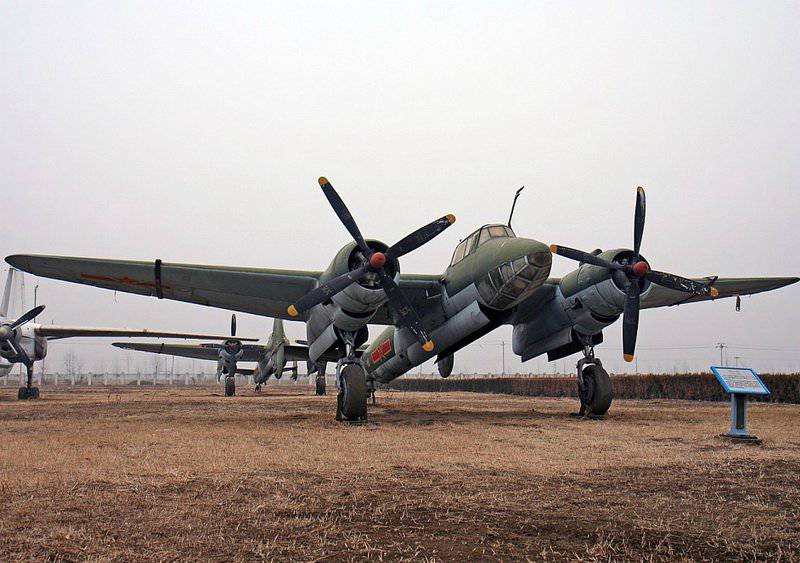
Aircraft crews usually included 4-s (could vary from 2-x to 5-i). The design of the Tu-2 was completely all-metal, riveting secret. The fuselage of the aircraft was a semi-monocoque with a frame. In a typical version, the bomber’s armament consisted of 2 20 aviation X-mm ShVAK-20 cannons, which were fixedly mounted in the center section at the sides of the fuselage. To protect the rear hemisphere, 3-5 XKUM machine guns of 7,62-mm caliber, installed in 2-3 rifle points, were used, could later be replaced with more powerful UB 12,7-mm machine guns.
In the summer of 1941, the plane showed outstanding flight data during state tests and was recommended for release. However, it was not possible to organize a mass production of the machine at that time, mainly due to the fact that the AM-37 aircraft engines it used were not commercially available. In this regard, there was a need to develop a new version of the aircraft under the engine M-82, which had recently passed a series of state tests. Even before the evacuation, the design bureaus of A. N. Tupolev had almost completed all the work on designing the aircraft for this engine. The M-82 differed from the AM-37 in that it had more power, a noticeably greater mid-section and a lower altitude. The new version of the bomber received the designation “103В” and already in December 1941 began flight tests, which demonstrated that the maximum speed of the 103М was significantly lower than that of the 103®, although at low altitude the speed of the dive bats were comparable. Even in the course of testing "103В" preparation for its mass production was started, which was launched in Omsk in the summer of 1942.
In September, 1942, the first serial Tu-2 dive bombers were sent to the front for a series of military trials. Front-line pilots appreciated the quality of the new car. They noted the ease in mastering the bomber, the increased survivability of air-cooled motors, the ability to continue flying on one engine, and a good defensive fire pattern. Showed the plane and quite outstanding speed, on the tests of the Tu-2 overclocked to 547 km / h. The ceiling of the car was 9 500 meters with a bomb load of 1 tons, while in an overload the plane could take on board up to 3 tons of bombs.
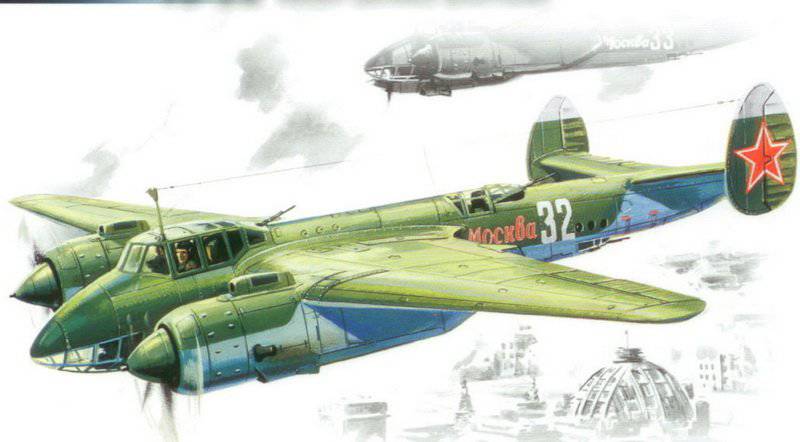
It would seem that the plane should now go into mass production, but this did not happen. Moreover, it was decided to terminate the bomber production with such difficulty for the organization of production at the Yak fighter plant. Nowadays such a solution seems frankly illogical. Despite the fact that the release of the Tu-2 was stopped, it was clear and confirmed by combat tests on the Kalinin front that an aircraft such as the Tu-2 would be indispensable to ensure further major offensive operations.
That is why, already in 1943, the decision to start production of this aircraft was made again, but at other plants. As a result, the serial Tu-2 reappears at the front only at the end of the 1943 year. At the same time, the new aircraft differed significantly from the Tu-2 model 1942 of the year. During this time, the design team under the leadership of Tupolev carried out serious work aimed at simplifying the design and production of his car. The result of this was that the cost of producing only one Tu-2 was reduced by approximately 20%, while its weight decreased, and reliability and survivability was further increased. In addition, the bomber received new engines ASH-82FN, which provided him with a speed increase at 20-25 km / h. It was also heavily defensive aircraft armament. In addition, the bomber, which was named Tu-2C, could be used with minor modifications in the variants of a long-range bomber, torpedo bomber and reconnaissance aircraft. At the same time, only the Tu-2C bomber version was produced in the mass series.
The new dive bomber had a number of important advantages compared with the Pe-2. He could lift into the air 3 times as many bombs (3 000 kg. Against 1 000 kg). In addition, on his internal suspension he could even carry bombs weighing 1000 kg., While the Pe-2 internal bomb compartment contained only 100-kg ammunition. In addition, the aircraft could drop bombs in a dive, not only from the external suspension, like the Pe-2, but also from the inside, and also had more powerful defensive armament. Its flight range was almost twice as long as that of the Pe-2 (2000-2200 km. Vs. 1200-1300 km.). At the same time, the car was distinguished by the best aerobatic qualities, but the speed characteristics of the aircraft were very close.
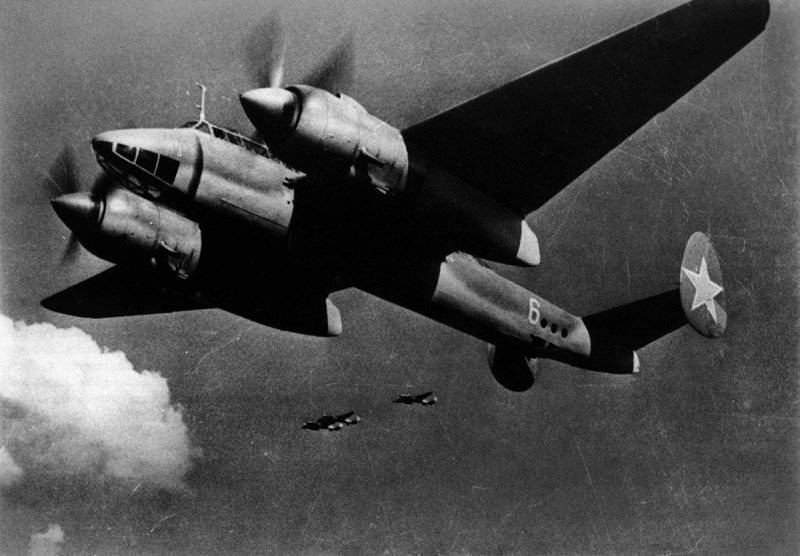
In all its variants and modifications, the design scheme remained unchanged. Changed equipment, weapons, engines. The dimensions of the aircraft varied only slightly, with the exception of models with increased flight range, in which the area of the tail and wing was noticeably increased. During the years of the Great Patriotic War, Soviet industry was able to produce about 800 dive-bombers Tu-2, which proved to be excellent in battles. After the war, the aircraft was mass-produced for a few more years; a total of 2 527 data vehicles were released.
Tactical and technical characteristics of the Tu-2С:
Dimensions: wingspan - 18,86 m., Length - 13,8 m., Height - 4,13 m.
Wing area - 48,8 square. m
Aircraft take-off weight - 10360 kg.
Engine type - 2 ASH-82FN, power of each 1850 hp
The maximum speed is 547 km / h.
Practical range: 2150 km.
Practical ceiling: 9 500 m.
Crew - 4 person.
Armament: 2X20-mm ShVAK cannon, 3x12,7-mm UB machine gun.
Bomb load normal - 1 000 kg, maximum - 3 000 kg.
Information sources:
- http://www.airwar.ru/enc/bww2/pe2.html
- http://www.airpages.ru/ru/pe2_1bp.shtml
- http://world-of-avia.narod.ru/tu2.htm
- http://en.wikipedia.org/
This popular science film tells about the Pe-2 - "Pawn." Pe-2 was the most massive front-line diving bomber manufactured by the USSR. In a small bomber aviation this type of weapon was the most productive. Pe-2 production ceased in the winter of 1945-1946. These machines were built more than any other Soviet bombers. After the war, the Pe-2 was quickly removed from service with Soviet aircraft and replaced with more advanced Tu-2s. About Tu-2, as a worthy replacement for the "Pawn", we will also tell you in this film.
Information